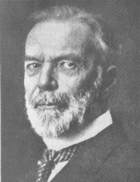
1856-1943
Wilhelm Geiger studied the Avesta and the culture of ancient Iran. Later, he became interested in Buddhism and the culture of Ceylon. Geiger's contributions were outstanding in both fields. His interests were not confined to philological and historical subjects. He also studied contemporary political problems and contributed articles to daily newspapers.
Wilhelm Ludwig Geiger was born on 21.7.1856 in Nuernberg. He studied classical and Oriental philology in Erlangen, Bonn, and Berlin. He obtained a doctorate for the thesis Die Pehlevi Version des Ersten Capitels des Vendidad ("The Pehlevi Version of the first Chapter of the Vendidad"). Geiger passed his state examination in Greek and Latin at the same time. He worked for-some time as school teacher and then qualified as a university professor. In 1891, he became professor of Indo-European languages in Erlangen. From 1920 to 1929 he held the chair of Aryan languages at Muenchen. Three journeys to Ceylon enabled Geiger to see the country and meet the people of the island. However, he never visited either Iran or India. After his retirement, he continued writing almost until the last day of his life. He died in Neubiberg near Muenchen on 2.9.1943.
Geiger published a treatise Aogemadaeca, ein Parsentraktat in Pazend, Altbaktrisch und Sanskrit ("Aogamadaeca, a Parsee treatise in Pazend, Old Bactrian and Sanskrit"). This text deals with the omnipotence of death. In 1879, he published an introduction to the Avesta language together with a reader, grammar and glossay entitled Handbuch der Awestasprache, Grammatik, Chrestomathie und Glossar.
In his doctoral thesis Geiger expressed the view that Avestan scriptures originated in Eastern Iran before the Median and Persian empires. Since other scholars were sceptical about this view Geiger wrote on the subject again in "Proceedings of the Bavarian Academy", 1884 in the paper Vaterland und Zeitalter des Avesta und seiner Kultur ("Home and Age of the Avesta and its Culture"). Geiger's most important book, Ostiranische Kultur im Altertum "Civilization of Eastern Iranians in Ancient Times" was translated by D.D.P. Sanjana, 1885/87. "Zarathustra in the Gathas and in the Greek and Roman Classics, translated from the German of Drs. Geiger and Windischmann", 1899.
Geiger brought out a geographical monograph on the Pamirs, 1887. He also contributed a paper Yatkar-i-Zariran and its relations to the Shahname' to "Proceedings of the Bavarian Academy", 1890. This only extant piece of Middle Iranian epic poetry was partly incorporated in the Shahname of Firdausi.
Geiger's occupation with the languages of Iran in ancient times led him to study modern dialects, i.e. Baluchi and Afghan. Togehter with E. Kuhn, Geiger published Grundriss der Iranischen Philologie ("Encyclopedia of Iranian Philology"), 1895-1904.
Geiger's first Indological study was Elementarbuch des Sanskrit Unter Beruecksichtigung der vedischen sprache, ("Elementary book of Sanskrit under consideration of the Vedic language"). Its third edition appeared 1923 and was reprinted in 1982. His journey to Ceylon enabled him to study the languages of that island, and he published the results in "Proceedings of the Bavarian Academy." He contributed Literatur und Sprache der Singhalesen to the "Encyclopedia of Indo-Aryan Research." Geiger established beyond doubt that Singhalese is an Aryan language, which he considered to be based on a Prakrit dialect of North Western India. The languages of the Rodiyas, a 'low' caste and the tribal Veddas were also subjects of Geiger's studies. He came to the conclusion that Rodiya was similar to the Singhalese spoken by the lower strata of society. Likewise, the language of the Veddas was Singhalese in character. A considerable number of words, however, were remnants of the original language of the Veddas. The Maladive Islands were colonised by the Singhalese, Geiger showed in his Maldivian Linguistic Studies, Colombo 1919. In 1938, Geiger wrote a Singhalese Grammar. His Glossary of the Singhalese Language, and Studien zur Geschichte und Sprache Ceylons appeared in 1941.
In 1916, Geiger contributed Pali Literatur und Sprache ("Pali Language and Literature") to the "Encyclopedia of Indo-Aryan Research". He thought that Pali was a lingua franca based on Magadhi and that it was the language used by the Buddha.
The Critical Pali Dictionary that Geiger had planned did not materialise. The material that he had collected for this project was later used by the Danish Academy of Sciences. His "Dictionary of the Singhalese language" appeared in 1935.
In collaboration with his wife Magdalene he wrote a monograph Pali Dhamma, vornehmlich in der kanonischen Literatur ("Pali dhamma, especially in canonical literature"), in which the authors discussed the meanings of terms like law, order, character, teaching, etc. Geiger translated several sermons of the Buddha from the Samyutta Nikaya. He also contributed many papers for the journal Zeitschrift fuer Buddhismus, which he edited.
Geiger also contributed to the study of Ceylonese history and culture. Already in 1905 Geiger wrote Dipavamsa und Mahavamsa und die geschichtliche Ueberlieferung in Ceylon. (He was of the opinion that the chronicles were based on a lost Sinhalese commentary on the Buddhist cannon). In 1908, he edited the chronicle Mahavamsa. In 1912 the translation of this text followed. The Culavamsa appeared in 1925, 1927, the translation in 1929, 1930. In Die Quellen des Mahavamsa ("The Sources of the Mahavamsa"), 1929, Geiger stated that other sources too must have been used.
After Geiger's death, H. Bechert published his Culture of Ceylon in Medieval Times, 1960. Here Geiger describes Ceylonese culture from 362 to 1505 in all its aspects.
K. Zistl published a bibliography of Geiger's works in "Yoga" 1,1931.